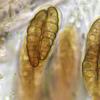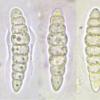
20-11-2008 15:59
Juste pour demander ce qui se fait de mieux pour d

19-11-2008 15:02
 Yannick Mourgues
Yannick Mourgues
Bonjour à tous. Je m'interroge sur cette espè

15-11-2008 15:53
Roland LabbéIl y aura bientôt une photo d'un disco dont je me

14-11-2008 23:30
Bonsoir, Je sais que le genre Gibberella est diff
Phaeosphaeria on Juncus cf conglomeratus
Björn Wergen,
17-03-2012 23:47
 Hi,
Hi,I am trying to identify this small Phaeosphaeria growing on dead Juncus stems. It could be something around P. volkartiana - P. minuscula, but my literature (Leuchtmann 1984, Shoemaker&Babcock 1989) does not give me a species with the spore size 22-25x6-7µm.
The perithecia are very small (around 100-130µm), black, with indistinct ostiolus and partly embedded into epidermis. Asci are 80-105x11-14µm.
Mature spores almost have 6-7 septa with 5. cell thicker than the others. Lower part tapered, the whole spore surface is regularly echinulate as seen on the photos.
Une idée? merci pour votre l'aide.
amicalement,
björn
Björn Wergen,
18-03-2012 00:02

Re : Phaeosphaeria on Juncus cf conglomeratus
Massariosphaeria typhicola and M. adrianii are also very similar in spore shape and surface, but have bigger size (M. typhicola 27-32x5-7µm, one finding on Juncus sp., M. adrianii 30-37x8-10µm, on Scirpus).
:/
edit: Ok I would call my finding as Massariosphaeria typhicola. If someone has another idea, please tell me ;)
regards,
björn
:/
edit: Ok I would call my finding as Massariosphaeria typhicola. If someone has another idea, please tell me ;)
regards,
björn
Alain GARDIENNET,
18-03-2012 07:54
Re : Phaeosphaeria on Juncus cf conglomeratus
Hi Björn,
Yes, You're probably right. It's very closed to M. typhicola. Perhaps if you check again ascomatas, you will find longer ascospores ? Perhaps not and it would be interesting.
For waiting, keep this M. sp. cf typhicola in herbarium.
Alain
Björn Wergen,
18-03-2012 10:13

Re : Phaeosphaeria on Juncus cf conglomeratus
Hi Alain,
thank you for the opinion. Yes it would be interesting if there are no other bigger spores. This record was random, I just chipped up something from the surface and had only one fruitbody between substrate material. I did not expect it in this preparation. I hope I can find another fruitbody, if yes, I will check again and tell you something more about the spore size.
regards,
björn
thank you for the opinion. Yes it would be interesting if there are no other bigger spores. This record was random, I just chipped up something from the surface and had only one fruitbody between substrate material. I did not expect it in this preparation. I hope I can find another fruitbody, if yes, I will check again and tell you something more about the spore size.
regards,
björn
Björn Wergen,
18-03-2012 12:56

Massariosphaeria sp. and M. typhicola?
Hi Alain,
I have made numerous preparates and only one of them had 2 additional fruitbodies with a bigger spore size (23-28x6-7µm). I think it is not mature at all because most spores were inside the asci.
In one of the preparates there were some other spores without asci. I took a photo of them too.
amicalement,
björn
and notice, all preparates were made from the same Juncus stem.
I have made numerous preparates and only one of them had 2 additional fruitbodies with a bigger spore size (23-28x6-7µm). I think it is not mature at all because most spores were inside the asci.
In one of the preparates there were some other spores without asci. I took a photo of them too.
amicalement,
björn
and notice, all preparates were made from the same Juncus stem.
Alain GARDIENNET,
18-03-2012 12:59
Re : Phaeosphaeria on Juncus cf conglomeratus
Nice photos.
It really looks like M. typhicola.
Alain
It really looks like M. typhicola.
Alain
Björn Wergen,
18-03-2012 13:05

Re : Phaeosphaeria on Juncus cf conglomeratus
All of them???
Mysterious. But very interesting. I will collect some more Juncus stems next time, even if there is nothing to see :P
Thanks Alain.
Mysterious. But very interesting. I will collect some more Juncus stems next time, even if there is nothing to see :P
Thanks Alain.
Alain GARDIENNET,
18-03-2012 13:21
Re : Phaeosphaeria on Juncus cf conglomeratus
All of them ?
Yes, I think. Ther is probablity variability in ascospores' length.
Alain
Yes, I think. Ther is probablity variability in ascospores' length.
Alain
Björn Wergen,
18-03-2012 13:24

Re : Phaeosphaeria on Juncus cf conglomeratus
I mean the hyaline spores with 7-8 septa, surrounded by a sheath. I cannot imagine such a variability?
Alain GARDIENNET,
18-03-2012 15:06
Re : Phaeosphaeria on Juncus cf conglomeratus
I talked about the one with brown ascospores. For the one with hyaline ascospores (if you think it's different), see towards M. roumeguerii.
Perhaps the answers to your questions are in Leuchtmann (über Phaeosphaeria ...)
Alain
Perhaps the answers to your questions are in Leuchtmann (über Phaeosphaeria ...)
Alain
Björn Wergen,
18-03-2012 15:21

Re : Phaeosphaeria on Juncus cf conglomeratus
Yes, I will look in Leuchtmann later, there are lots of other records these days which want to have a name :D
If there is something more of this M. roumegueri, I will post it here ;)
regards,
björn
If there is something more of this M. roumegueri, I will post it here ;)
regards,
björn
Hiran Hiran Anjana Ariyawansa,
18-03-2012 16:42
Re : Phaeosphaeria on Juncus cf conglomeratus
Dear friend
This fungi seems to be very intersting i am working on pleosporales missing types and their phylogeny if you can send me a specimens then i can work on it and do sequecing
I look forward to hearing from you
Thanks
Hiran
This fungi seems to be very intersting i am working on pleosporales missing types and their phylogeny if you can send me a specimens then i can work on it and do sequecing
I look forward to hearing from you
Thanks
Hiran






